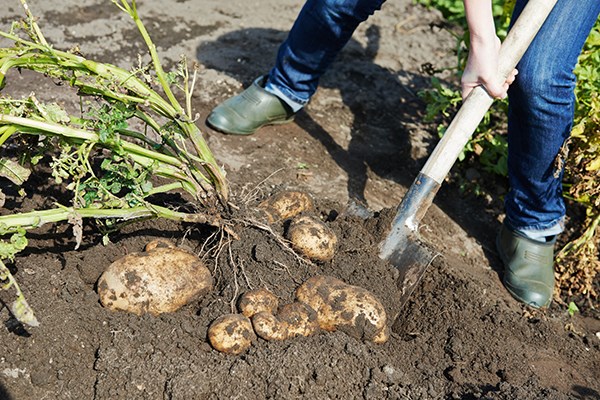Of all the veggies we are able to grow in our home gardens, there is nothing finer than freshly dug potatoes. Harvesting new potatoes is almost like finding buried treasure. Your hands start to gently scratch at the base of the green potato plant, then they dig down into the soft loamy soil, and you’re not sure if today will be your lucky day.
The inexplicably cool moment when your fingers feel those hard nuggets of deliciousness is pure joy. This, my friends, is why we grow vegetables.
Potatoes are among the earliest vegetables planted in the spring garden. The potato isn’t a root but a tuber, and when you start your seed potato shopping, you’ll find early season, mid-season and late varieties. There are literally hundreds of types of seed potatoes available and they are all good. I always suggest to grow what you use and what you like.
The one type of seed potato not to buy is the run-of-the-mill potato that you buy to eat at the grocery store. Buy certified seed potatoes, which are meant for growing and will not harbour chemicals and the chance of diseases and pests being introduced into the soil.
The debate about when to plant your seed potatoes is lengthy, but generally, you want to plant them two to three weeks from your average last frost date. I haven’t scraped my car windows in weeks, so in Squamish we are good to plant. Early and mid-season types can be planted midway through April, and late-season types can be planted as late as July for a fall harvest and winter storage.
Seed potatoes come in all shapes and sizes. I like to plant smaller potatoes with at least two to three “eyes” (the places where the new stems grow out of the tubers) on them. If your seed potatoes are large, you probably want to cut them into two-inch chunks before planting. Ensure that each piece you cut has two or three eyes, giving them their best chance for growing success. After cutting, let them dry out for a couple of days to scab over and heal. Now you’re ready to plant.
Your seed potatoes will come with planting instructions regarding depth and space for each individual variety.
A general planting rule of thumb is to make a trench four to eight inches deep (depending on how big your potato or piece is), plant the seed pieces 10 to 12 inches apart, and if you like rows, plant the rows 24 to 36 inches apart.
The best plan is to have incorporated plenty of organic matter into your soil the previous fall and to start your planting in good rich, loamy soil.
You can add some organic vegetable fertilizer into the trenches when planting, but don’t add fresh manure; this tends to make potatoes scab. Potatoes like plenty of sun, and once the green potato plants rise above the soil and make white flowers, new potatoes are forming beneath the soil. You need to keep up on regular watering at this point if Mother Nature isn’t doing her job.
Once the potatoes start to grow and the shoots appear above the soil line, you mound up each plant with a ridge of soil so that the shoots are just buried. This is sometimes referred to as “hilling” and you will need to do this at regular intervals throughout the growing season. Keep on top of weeding when the plants are young as they don’t like competition.
Most importantly, enjoy your harvest.



